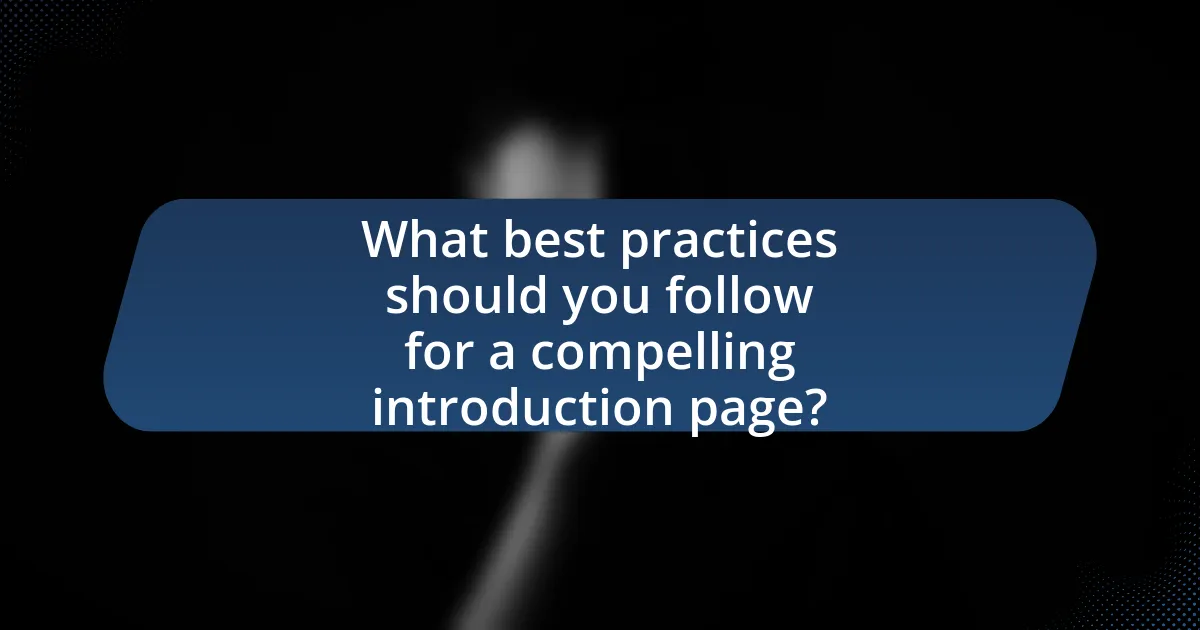A strong introduction page is essential for a portfolio as it creates the first impression and establishes the viewer’s experience. This article outlines the critical elements of an effective introduction page, including a clear purpose statement, engaging visuals, and concise personal information. It emphasizes the impact of layout on first impressions and the importance of tailoring content to the audience to enhance engagement. Additionally, the article discusses common mistakes to avoid, the role of storytelling, and best practices for design elements that contribute to a compelling introduction page, ultimately highlighting how these factors influence personal branding and viewer perception of the work presented.

Why is a Strong Introduction Page Crucial for Your Portfolio?
A strong introduction page is crucial for your portfolio because it serves as the first impression and sets the tone for the viewer’s experience. This initial page captures attention, communicates your unique value proposition, and establishes your professional identity. Research indicates that users form opinions about a website within 50 milliseconds, highlighting the importance of an engaging introduction. A well-crafted introduction can increase viewer engagement and retention, ultimately leading to more opportunities.
What elements make up an effective introduction page?
An effective introduction page consists of a clear purpose statement, engaging visuals, and concise personal information. The purpose statement outlines the goals of the portfolio, helping viewers understand its intent. Engaging visuals, such as a professional photo or relevant graphics, capture attention and create a connection with the audience. Concise personal information, including background and skills, provides context and establishes credibility. Research indicates that portfolios with well-structured introduction pages significantly enhance viewer engagement and retention, as evidenced by studies showing that clear messaging increases comprehension by up to 70%.
How does the layout of the introduction page impact first impressions?
The layout of the introduction page significantly impacts first impressions by influencing user engagement and perception of professionalism. A well-structured layout, characterized by clear headings, organized content, and visually appealing design, facilitates easier navigation and comprehension, which can enhance the viewer’s initial experience. Research indicates that users form opinions about a website’s credibility within milliseconds, emphasizing the importance of an effective layout in establishing trust and interest. For instance, a study by the Nielsen Norman Group found that 94% of first impressions are design-related, underscoring how layout directly affects user perception and engagement.
What content should be included to engage the audience?
To engage the audience, the content should include a compelling narrative that highlights personal achievements, relevant skills, and unique experiences. This narrative should be supported by visual elements such as high-quality images or videos that showcase work samples, as studies indicate that visuals can increase engagement by up to 94%. Additionally, incorporating testimonials or endorsements from clients or colleagues can enhance credibility and foster trust, as 79% of consumers trust online reviews as much as personal recommendations. Clear calls to action, inviting the audience to explore further or connect, also play a crucial role in maintaining engagement.
How does a strong introduction page influence your overall portfolio?
A strong introduction page significantly enhances your overall portfolio by creating a compelling first impression that engages viewers. This initial engagement is crucial, as studies show that first impressions are formed within seconds, influencing the viewer’s perception of the entire portfolio. A well-crafted introduction page effectively communicates your unique value proposition, showcases your skills, and sets the tone for the work presented, thereby increasing the likelihood of capturing the audience’s interest and encouraging further exploration of your projects.
In what ways can it enhance your personal brand?
A strong introduction page in your portfolio enhances your personal brand by establishing a clear and compelling first impression. This page serves as a concise summary of your skills, experiences, and unique value proposition, allowing potential clients or employers to quickly understand what you offer. Research indicates that 94% of first impressions are design-related, highlighting the importance of visual appeal and clarity in branding. Furthermore, a well-crafted introduction page can improve your online visibility and searchability, as it often contains keywords relevant to your industry, making it easier for others to find you.
How does it affect the viewer’s perception of your work?
A strong introduction page in a portfolio significantly enhances the viewer’s perception of the work. It establishes an immediate connection, showcasing the creator’s intent, style, and professionalism. Research indicates that first impressions are formed within seconds; a well-crafted introduction can lead to increased engagement and interest, as evidenced by a study from Princeton University, which found that visual appeal influences judgment of competence and likability. Therefore, an effective introduction page not only captures attention but also positively shapes the viewer’s overall evaluation of the portfolio.

What are the common mistakes to avoid in your introduction page?
Common mistakes to avoid in your introduction page include being overly vague, neglecting to highlight key achievements, and failing to establish a personal connection with the audience. Being vague can lead to confusion about your identity and purpose; clarity is essential for engagement. Neglecting key achievements diminishes the impact of your introduction, as specific accomplishments provide credibility and showcase your skills. Lastly, failing to establish a personal connection can make your introduction feel impersonal, which may disengage readers. Research indicates that personal storytelling enhances relatability and memorability, making it crucial for effective introductions.
How can vague language undermine your introduction page?
Vague language can undermine your introduction page by creating confusion and failing to convey your message clearly. When an introduction lacks specificity, it can lead to misunderstandings about your skills, experience, and the purpose of your portfolio. Research indicates that clear and concise communication significantly enhances user engagement; for instance, a study by the Nielsen Norman Group found that users are more likely to trust and interact with content that is straightforward and easy to understand. Therefore, using precise language is essential for effectively capturing the audience’s attention and establishing credibility.
What specific phrases should be avoided to maintain clarity?
To maintain clarity, phrases such as “I think,” “in my opinion,” and “it seems” should be avoided. These expressions introduce ambiguity and weaken the assertiveness of the statements, making it unclear whether the information presented is factual or subjective. Research indicates that clear communication enhances understanding and engagement, particularly in professional contexts like portfolio introductions, where decisiveness is crucial for making a strong impression.
How does excessive information detract from your main message?
Excessive information detracts from your main message by overwhelming the audience and obscuring key points. When too much content is presented, it can lead to confusion, making it difficult for the audience to identify the core message. Research indicates that cognitive overload occurs when individuals are faced with more information than they can process, resulting in decreased retention and understanding. For instance, a study published in the journal “Cognitive Load Theory” by Sweller et al. demonstrates that information overload can hinder effective communication and decision-making. Therefore, maintaining clarity and focus is essential for ensuring that the main message is effectively conveyed and understood.
Why is it important to tailor your introduction page to your audience?
Tailoring your introduction page to your audience is crucial because it directly influences engagement and comprehension. When the content resonates with the specific interests and needs of the audience, it enhances their connection to the material, making them more likely to explore further. Research indicates that personalized content can increase user engagement by up to 74%, demonstrating the effectiveness of audience-centric approaches. By aligning the introduction with the audience’s expectations, you create a more inviting and relevant experience, which is essential for maintaining their attention and fostering a positive impression of your portfolio.
How can understanding your audience improve your introduction page?
Understanding your audience can significantly enhance your introduction page by tailoring content that resonates with their interests and needs. When the introduction page addresses specific demographics, preferences, and pain points, it increases engagement and encourages visitors to explore further. Research indicates that personalized content can lead to a 20% increase in conversion rates, demonstrating the effectiveness of audience-centric approaches. By analyzing audience data, such as age, profession, and motivations, creators can craft a compelling narrative that aligns with what the audience values, ultimately making the introduction page more impactful and relevant.
What strategies can you use to connect with different audience types?
To connect with different audience types, tailor your messaging and presentation style to their specific preferences and needs. For instance, use data-driven insights and professional language to engage a corporate audience, while adopting a more casual tone and storytelling approach for creative individuals. Research indicates that audience segmentation enhances engagement; a study by the Content Marketing Institute found that 72% of marketers believe personalized content improves customer engagement. By understanding the demographics, interests, and pain points of each audience type, you can create targeted content that resonates effectively, thereby fostering a stronger connection.

What best practices should you follow for a compelling introduction page?
To create a compelling introduction page, focus on clarity, engagement, and relevance. A clear introduction should succinctly convey the purpose of the portfolio, capturing the audience’s attention within the first few sentences. Engaging content can include a personal story or a unique perspective that reflects the creator’s personality and values, making the introduction relatable. Relevance is achieved by aligning the introduction with the overall theme of the portfolio, ensuring that it sets the stage for the work presented. According to research by the Nielsen Norman Group, users form opinions about a website within 50 milliseconds, emphasizing the need for an impactful introduction.
How can storytelling enhance your introduction page?
Storytelling can enhance your introduction page by creating an emotional connection with the audience, making the content more engaging and memorable. When a narrative is woven into the introduction, it captures attention and encourages readers to invest in the material. Research indicates that stories activate multiple areas of the brain, leading to better retention of information; for instance, a study by Paul Zak found that narratives can increase empathy and engagement, which are crucial for effective communication. By incorporating storytelling elements, such as personal experiences or relatable scenarios, the introduction page can effectively convey the creator’s values and vision, ultimately fostering a deeper connection with the audience.
What techniques can you use to create a narrative that resonates?
To create a narrative that resonates, utilize techniques such as emotional storytelling, relatable characters, and vivid imagery. Emotional storytelling engages the audience by tapping into their feelings, making the narrative more impactful. Relatable characters allow readers to see themselves in the story, fostering a connection that enhances engagement. Vivid imagery paints a clear picture in the audience’s mind, making the narrative more memorable. Research indicates that narratives incorporating these elements can increase retention and emotional response, as evidenced by studies showing that stories with emotional content are more likely to be remembered than those that are purely factual.
How does personalizing your story make a difference?
Personalizing your story enhances engagement and relatability, making it more impactful. When individuals share their unique experiences, it fosters a deeper connection with the audience, as personalized narratives resonate on an emotional level. Research indicates that storytelling that incorporates personal elements can increase retention and understanding by up to 65%, as it allows listeners to see themselves in the narrative. This connection not only captures attention but also encourages trust and authenticity, which are crucial for a strong introduction page in a portfolio.
What design elements contribute to an effective introduction page?
An effective introduction page incorporates clear typography, engaging visuals, and a concise layout. Clear typography ensures readability and guides the viewer’s attention, while engaging visuals, such as images or graphics, create an emotional connection and enhance interest. A concise layout organizes information logically, allowing users to navigate easily. Research indicates that 38% of users will stop engaging with a website if the content or layout is unattractive, highlighting the importance of these design elements in retaining viewer attention.
How do color schemes and typography affect readability and engagement?
Color schemes and typography significantly influence readability and engagement by enhancing visual clarity and emotional response. Effective color schemes, such as high-contrast combinations, improve text legibility, while harmonious palettes can evoke specific feelings, thereby capturing attention. Research indicates that 90% of information transmitted to the brain is visual, emphasizing the importance of color in communication. Typography, including font choice and size, directly impacts how easily text can be read; for instance, sans-serif fonts are generally more legible on screens. Studies show that well-chosen typography can increase reading speed by up to 20%. Together, these elements create an inviting and accessible user experience, fostering greater engagement with content.
What role do images and graphics play in enhancing your introduction?
Images and graphics play a crucial role in enhancing introductions by capturing attention and conveying information quickly. Visual elements can increase engagement, as studies show that people process images 60,000 times faster than text, making them effective for immediate comprehension. Additionally, relevant visuals can reinforce the message of the introduction, providing context and emotional resonance that text alone may lack. For instance, a well-chosen graphic can illustrate a key point or theme, making the introduction more memorable and impactful.
What are some practical tips for creating a strong introduction page?
To create a strong introduction page, focus on clarity, engagement, and relevance. Start with a concise and compelling opening statement that clearly defines your purpose and what the audience can expect. Use a professional tone and ensure that the design is visually appealing, incorporating elements like a clean layout and appropriate images that reflect your personal brand. Additionally, include a brief overview of your skills and experiences, highlighting key achievements that are relevant to your audience. Statistics show that portfolios with strong introductions can increase viewer engagement by up to 50%, emphasizing the importance of making a strong first impression.





